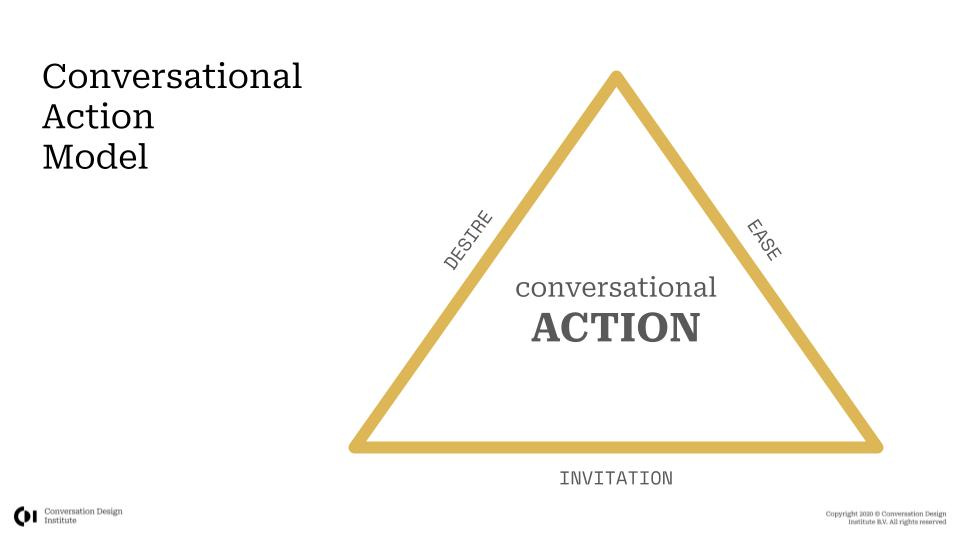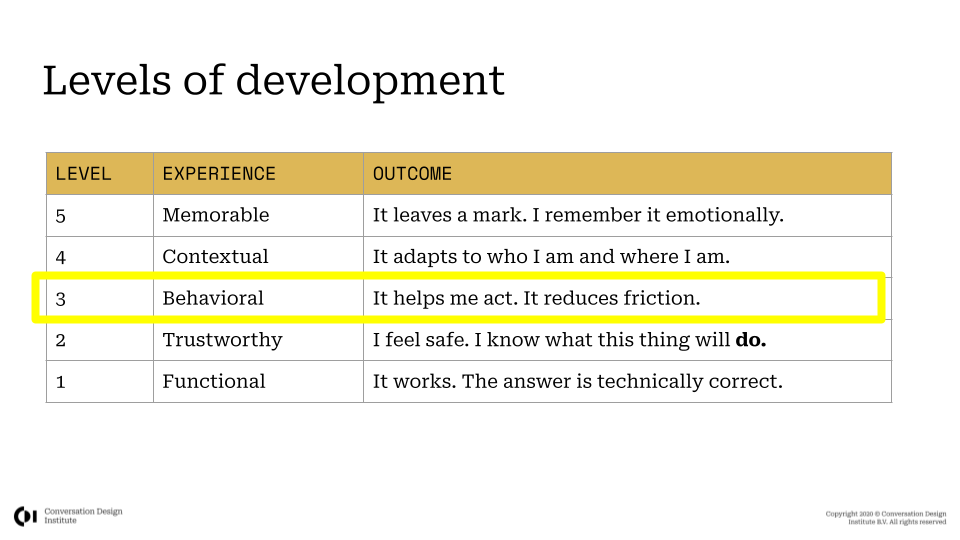Why Your AI Isn't Working: The Conversational Action Model
A simple lens that explains why customers don't act—and how to fix it.
Your AI assistant isn't failing.
Your customer just isn't acting.
And that's still your fault.
We’ve seen this happen a thousand times. A team builds a smart, capable assistant. It answers questions, pulls data, hands things off to agents. The scripts are clean. The tech works. But somehow, customers still vanish.
They hesitate. Drop off. Ghost.
The problem isn’t technical. It’s behavioral.
That’s where the Conversational Action Model comes in. It’s a dead-simple framework for designing conversations that actually move people to do something.
There are three levers to work with.
Invitation – Are we asking them to act?
Desire – Do they want to?
Ease – Can they do it without friction?
If one of those breaks, the whole thing falls apart.There will be no action…
This isn’t some academic theory. It’s a practical tool we’ve used across hundreds of bot reviews, product builds, and customer journeys. It gives teams direction when they’re stuck and clarity when the journey gets too complicated to see clearly.
How it works in the real world
Say your best friend calls. You really want to talk. But your phone is on silent, face down on the table. You never hear it ring.
That’s a missing invitation.
Now imagine your phone rings again. But it’s a random salesperson. You hear it fine. You could pick up. But you don’t want to.
That’s a lack of desire.
Then your friend calls again. You hear it. You want to answer. But your hands are covered in dough.
That’s a breakdown in ease.
These moments shape everyday behavior. The same forces are at play in every customer interaction, whether it’s on a page, talking to a support agent, or in your AI Assistant.
So here’s how it shows up in your product
Invitation
No one clicks if they don’t feel invited. Too many assistants launch with vague intros like “Hi, how can I help you today?” That’s not an invitation. That’s passing the burden onto the customer.
And sometimes we overcorrect. We push way too many CTAs. Buttons, banners, nudges, pop-ups. But if there’s no desire underneath, it all falls flat.
Desire
Customers need a reason to act. Emotional relevance. Curiosity. Something that actually matters to them. They need to have some level of excitement for what you’re offering – whether its service, product, or even therapy.
Desire isn’t passive. It can be built. You create it with emotional framing, clear outcomes, urgency, and relevance.
A flat offer like “Want to learn more about our premium plan?” isn't going to cut it most of the time. Nobody wakes up wanting to “learn more.”
Ease
This is where most teams stumble. They’ve got the message. The CTA is visible. The user even wants to do it.
But now they’re staring at five buttons, all labeled with vague corporate jargon. Or they have to scroll through three screens of text to understand the next step.
Technically easy. Practically hard.
Ease isn’t just “can they do it.” It’s does this feel like zero friction?
Use it to design. Use it to diagnose.
This model works at every level:
A single message that confuses people
An entire flow that leads nowhere and gets people stuck
A full customer journey that feels like wandering through fog only to end up at a 404 page
When something isn’t working, don’t guess. Ask:
Did we clearly invite them?
Do they actually want to act?
Did we make it effortless?
When a customer doesn’t act, one of these is missing:
✅ Invitation
❤️ Desire
⚙️ Ease
It sounds basic. And yet... how often do you really check for all three? I mean to really look at the journey and ask yourself those questions…
At Conversation Design Institute, our reviews of AI assistants often reveal a common issue: they don’t drive user behavior effectively. Fixing that isn’t just possible — it’s one of the fastest ways to improve performance.
Design for behavior, not just conversation
Most teams are still stuck in “answer the question” mode. But real assistants guide people. They shape outcomes over time. One turn at a time.
That’s what it means to design for behavior. You’re not just solving a request. You’re guiding the customer to an outcome.
We worked with a large Amsterdam based bank that had built all the right infrastructure. Big team. Lots of meetings. But they were paralyzed.
Every conversation turned into a whiteboard mess: What if the customer says this? What if they do that? Infinite branches. Zero momentum.
We ran some workshops and introduced the model. It took a few sessions but then things started to shift.
Instead of mapping infinite paths, they started asking: What do we want the customer to do? Then they worked backwards:
How do we invite that?
How do we build desire?
How do we make it easy?
You’ll find that you can throw out complicated flowcharts when you really spend some time asking those simple questions…
Then we helped them with specific patterns to make it better. Better prompts, using concepts like social proof to build desire, and focusing on reducing cognitive load by simplifying messages.
Suddenly, the output of the team increased. Completion rates went up. And the cost to serve on those specific journeys started to trend in a different direction.
Because the team wasn’t trying to predict every behavior. They were designing for the right one.
Customers want you to lead them — but only if you know what they want and how to get them there.
When you figure that out, designs go from
What’s the account number?
to
Most people (social proof) get this sorted in less than 5 minutes (expectation management). What your account number?
Teach this to your team
If you lead a CX or AI team, this model should be muscle memory.
Because here’s what happens when you ignore it:
Your assistant looks dumb
Your automation rates flatline
Your ROI disappears
And here’s the worst part: your customers blame you, not the system.
At CDI, we go one step deeper. We connect these levers to proven behavioral techniques: social proof, urgency, anchoring, loss aversion. So when something’s missing, you know exactly what to pull from the toolbox.
Pull up five recent bot conversations. Ask your team:
Did we invite action?
Did we create desire?
Was it easy?
Some people might read this and say: this is just UX 101.
But if this is just UX 101, why do so few conversational assistants get it right?
Simple: The people building AI Agents don’t know how to design conversations. And most UX designers don’t know how to work with dialogue.
That gap is where trust in these systems dy. And where your customers stop acting – or caring.
What’s really at stake
If you don’t design for behavior, you’re not building customer experiences. You’re just spitting out language.
And customers feel it.
They bounce. They stall. They drop out.
This ties back to the Empathy Algorithm Grid. If you don’t access this layer of customer experience, you get stuck. There’s no progress. No loyalty. No ROI.
Customers don’t move. And neither does your business.
Final thought
People don’t act just because the system is live.
They act when:
They’re invited
They want it
And it feels effortless
Don’t just design conversations.
Design for action.
Invitation. Desire. Ease.
The Conversational Action Model.
Simple. Practical. Yours to use.
If you’re building AI assistants and care about automation, customer experience, and cost to serve — visit Conversation Design Institute to get it right. Trusted by teams at JP Morgan, Dexcom, Vodafone, T-Mobile, and Randstad.






Does AI do poetry 'yet,' or at all?
This the Light who came to be known
so, when She moved with with the Will,
of Night, with the weight of Gravity, that
Light who we all know became Day, and
the d'Ark johanna, She rainbowed every
color so deep all we can see are the
fathomless seas we call Black.
~~~~~~~~
https://guardens.substack.com/p/toinen-runo
~~~~~~~~